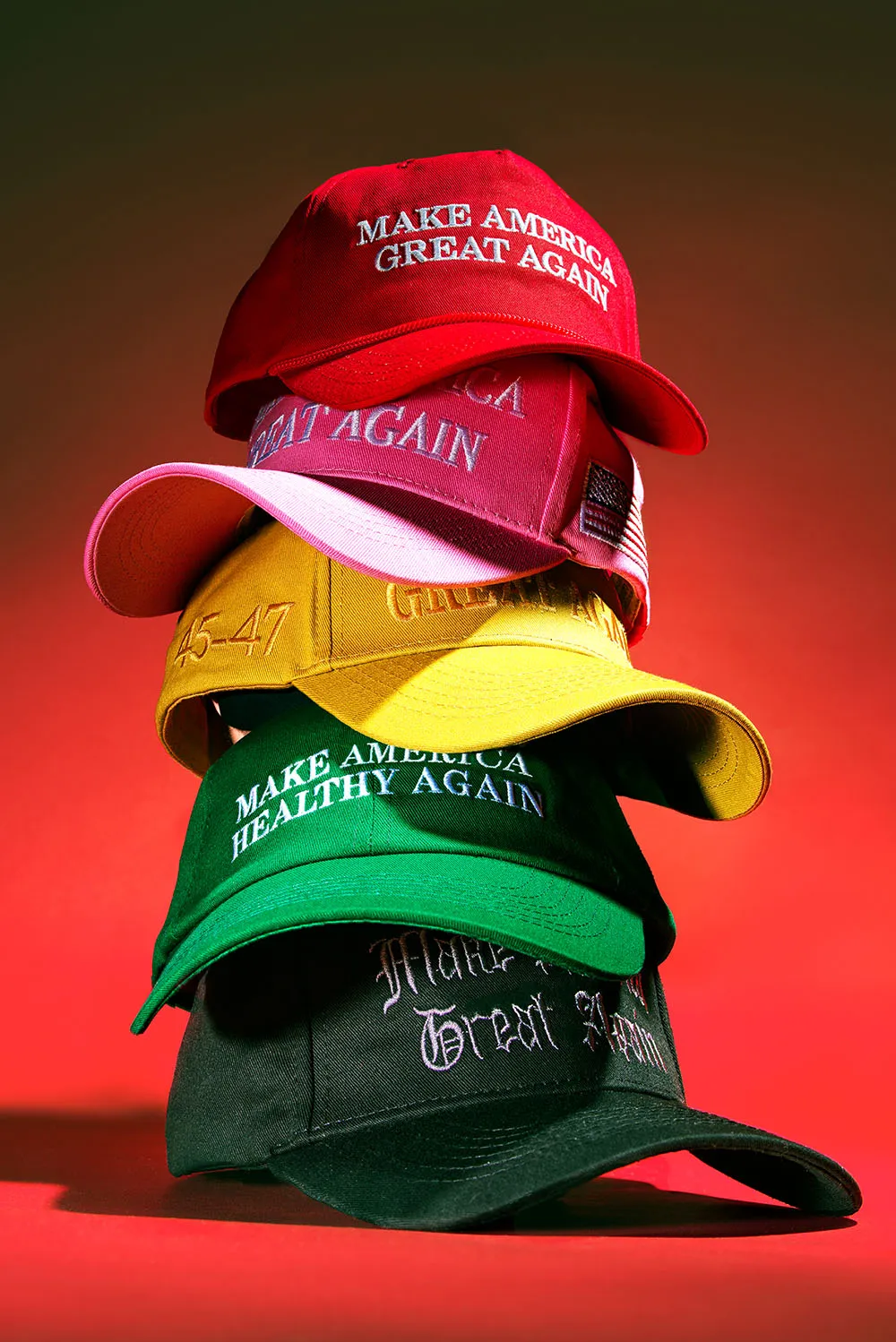The Shape-Shifting MAGA Hat

Andre Rucker photo for Foreign Policy
On July 23, 2015, just over a month into his first presidential campaign, Donald Trump arrived in Laredo, Texas, to visit the southern U.S. border. It was hot, even for Texas, so Trump eschewed his standard suit and red tie for a cooler, more casual look: a jacket, button-down, khakis, golf shoes, and a hat.
“He came around the corner and we all went, ‘Oh!’” news anchor Dana Bash, who covered the event, recalled in a CNN article in 2017.
On July 23, 2015, just over a month into his first presidential campaign, Donald Trump arrived in Laredo, Texas, to visit the southern U.S. border. It was hot, even for Texas, so Trump eschewed his standard suit and red tie for a cooler, more casual look: a jacket, button-down, khakis, golf shoes, and a hat.
“He came around the corner and we all went, ‘Oh!’” news anchor Dana Bash, who covered the event, recalled in a CNN article in 2017.
That day, Trump sported a white hat with his campaign slogan, Make America Great Again, in all caps and embroidered in navy blue. “I really remember it vividly because it was like, ‘Oh, of course, he’s the master marketer. Why wouldn’t he put it on a hat?’” Bash said.
It was the debut of the most polarizing accessory in recent history—that is, until the red-and-white version became available for purchase later that summer. In the tumultuous decade since then, the MAGA hat, as it’s become known, has evolved alongside Trumpism, from a fringe accessory to a universally recognized fashion statement. Along the way, as Trump has wrested control of the Republican Party, the MAGA hat has become a political force unto itself.
The original Make America Great Again hat worn by Donald Trump during a trip to Laredo, Texas, on July 23.Matthew Busch/Getty Images
No outside experts were consulted in the design of the iconic red MAGA hat. Trump merely sampled a few fonts and colors before landing on winners. The choices were a bit obvious: red for Republicans, Times New Roman because it’s a default font.
But taken together, the hat represented a radical departure from the optimized political aesthetics of the time. Unlike most campaign merch, the hat was embroidered with a slogan instead of the name of the candidate. It wasn’t pegged to any particular year or election, which, in hindsight, feels like foreshadowing. It was un-designed, un-focus-grouped, lazy, loud. There were no tricks up Trump’s design sleeves.
The MAGA hat, like its creator, was initially written off by the media and political establishments. Many pundits were confounded by the fact that Trump’s campaign spent more on hats than polling in the early months of the race. A September 2015 New York Times article dismissed it as “the ironic must-have fashion accessory of the summer.” A June 2016 Esquire article posited that the hats “may well go down as the Trump campaign’s only lasting contribution to the political history of the Republic.”
But for many Americans, MAGA hats were a runaway hit. Soon enough, the official hats, whose purchase is legally considered a campaign contribution, were bringing in $80,000 every day—in effect covering most of the 2016 campaign’s overhead costs.
In those early days, the hat’s power lay primarily in its ability to offend, shock, and provoke. Some of its supporters seemed to take pride in the fact that, like its designer, the hat transgressed civilities and political correctness. For many of its opponents, however, the MAGA hat would forever be a visual euphemism for the racism, sexism, and xenophobia they saw Trump as championing.
#gallery-2 {
margin: auto;
}
#gallery-2 .gallery-item {
float: left;
margin-top: 10px;
text-align: center;
width: 100%;
}
#gallery-2 img {
border: 2px solid #cfcfcf;
}
#gallery-2 .gallery-caption {
margin-left: 0;
}
/* see gallery_shortcode() in wp-includes/media.php */
- Delegates wear MAGA hats during the Republican National Convention in Milwaukee on July 17, 2024. Jim Watson/AFP via Getty Images
- A Trump supporter wears an oversized MAGA hat as he waits for the start of a rally in Manchester, New Hampshire, on Feb. 10, 2020. Drew Angerer/Getty Images
By the time Trump won in 2016, the hat had become so powerful that any resistance to his political agenda was insufficient without resistance to the hat itself. As Trump formalized his victory by adding a big, bold “45” detail to the hats, his opposition burned them at protests and knit pink pussyhats in droves to serve as an ideological counterweight.
During Trump’s first term, MAGA hats earned their reputation as a symbol of intimidation, worn by attenders of white nationalist rallies and school shooters alike. A controversial 2019 incident involving a white teenager in a MAGA hat filmed smirking at an Indigenous activist cemented the hat as the ultimate expression, depending on your perspective, of either empowerment or menace.
Just as Trump’s political ideology has changed and adapted as opportunity arises, so too has the hat. In Trump’s first term, the offerings expanded to include pink, rainbow, and even several different Halloween MAGA hats, as well as versions calling to make farmers and space great again. (This is to say nothing of the market for knockoffs, which has memeified the MAGA hat ad infinitum.)
In pursuit of a second term, the Trump campaign overhauled the MAGA hat into a bigger, louder, funhouse version of itself. The rectangular hats became taller overnight—square-shaped, with a stiffer, more structured face. A U.S. flag and “Trump 2020” were added on the side and back, respectively. While the original’s MAGA lettering was centered and proportionate to the size of the hat, on the new versions it was stretched to consume all available space, reading like a scream.
After Trump’s defeat in 2020, many wondered what would become of the hats. Typically, as reporter John Herrman noted at the time, when candidates lose, their merch is donated, recycled, or kept as keepsakes. “All of this relies, though, on the campaign actually coming to an end,” he wrote, before presciently asking: “What if it doesn’t?” Sure enough, as Trump supporters stormed the U.S. Capitol a few months later, MAGA hats littered the crowd.
During the interregnum that followed, the hats were an expression of intransigence among supporters, a message that four chaotic years of Trump’s rule had left their loyalties unchanged. Wearing MAGA hats also allowed Trump’s base to voice their support even as he made fewer headlines and public appearances.
In 2022, when Trump announced his intention to run again, he wasn’t wearing his signature hat. But at that point, he didn’t have to. The MAGA hat had taken on a life of its own.
His campaign went on to launch the “Little Red MAGA Hat,” a white hat decorated with an image of the classic red MAGA hat, styled almost like a museum exhibit. It was an indulgent piece of political merch; but for supporters, it paid homage to the hat’s symbolic evolution. Once an instrument of tribalism and trolling, it had become an object of respect, even reverence.
As the 2024 race heated up, the standard MAGA hat was reinvented once again with bold colors, an increased price tag, and “45-47” on the side—the hyphen implying, perhaps, that Trump never stopped being the legitimate president during Joe Biden’s supposedly stolen term.
U.S. Rep. Marjorie Taylor Greene wears a triumphant variation of the hat during Trump’s speech to Congress on March 4. Allison Robbert/AFP via Getty Images
Today, that “47” is no longer a campaign hope but reality.
After his reelection, Trump’s success cannot continue to be seen as fringe or surprising; it’s mainstream. And as stigmas against Trumpism have softened, the MAGA hat has lost some of its shock factor. Though many on the left still have a Pavlovian aversion to it, the hat is no longer as universally taboo or transgressive as it once was. A Washington Post article from last November documented the uptick in MAGA hats in Democratic enclaves, where victorious Trump supporters “are feeling newly emboldened to wear their beliefs on their heads.”
In its first decade, the MAGA hat has shape-shifted from an instrument of provocation to one of intimidation, from an expression of intransigence now to one of triumph. It’s a reflection of the changed meaning of Trump’s own presidency—his shift from hostile insurgency to newfound hegemony. To wear a MAGA hat today feels more like bragging than before; it’s a trophy wielded with confidence by members of the winning team. The slogan on a newly released official hat—“Trump was right about everything!”—reflects as much.
The breakout hat of this era belongs to its breakout political actor: Elon Musk. His signature Dark MAGA hat has stripped many of the original’s most Trumpian features and reimagined them in a supervillain’s likeness. The classic red and white is now a sleek black and gray. Certain versions use a font that has been likened to one associated with Nazis. Sometimes, in lieu of “45-47,” the side of the hat says, “Never Surrender.”
The MAGA hat is an accessory to Musk’s political power in the truest sense of the word. Throughout history, one of the primary purposes of hats has been to shield the wearer from the elements. True to form, Musk uses the MAGA hat as political shelter under which he can pursue his own ambitions with a clear symbol of Trump’s blessing. The visual shortcut spares the Republican Party from difficult conversations about whether Musk’s actions align with its values or serve its long-term interests. So long as something is done under the guise of making America great again or the shadow of a hat that says as much, it is fit for purpose.
Trump throws MAGA-esque hats that read “Save America” into the crowd at a rally in Wilmington, North Carolina, on Sept. 23, 2022.Allison Joyce/Getty Images)
At 10 years old, the MAGA hat is more powerful and pervasive than ever before. Its iconography has transcended borders and become a symbol embraced by political movements and leaders far beyond the United States. Anyone hoping to ingratiate themselves with or oppose Trumpism has few options for doing so that don’t involve the hat. For instance, in late January, Ontario Premier Doug Ford’s defiant “Canada Is Not for Sale” hat went viral as a rebuttal against Trump’s antagonism.
But this playbook—hats as the answer to hats—is tried and tired. Biden’s anti-MAGA victory hat aged poorly. The Harris-Walz camo hat was the accessory of the summer, but it was not enough to compensate for an unpopular establishment candidate. Even the pussyhats, popping up at protests once again, feel less like an expression of resistance than a bleak reminder of the political problems that remain unsolved a decade later.
Trump’s opponents have yet to form any meaningful opposition to his second term of rule. For those interested in undertaking such a task, I’d recommend thinking bigger than a hat this time around.
A scarf, perhaps?
This post is part of FP’s ongoing coverage of the Trump administration. Follow along here.
Megan DuBois is an assistant editor at Foreign Policy. X: @meganmdubois
More from Foreign Policy
-

Zelensky stands before four Ukrainian flags; cameras are pointed at him. It’s Time for Ukraine to Accept an Ugly Peace
Seven things for Zelensky to keep in mind as cease-fire negotiations start.
-

Then-presidential candidate Donald Trump speaks before a capacity crowd at a rally for his campaign on April 10, 2016 in Rochester, New York. Trump Is Not a Revolutionary
Not all political upheaval is created equal.
-

German soldiers unload the U.S.-made MIM-104 Patriot surface-to-air missile system in Jasionka, Poland. The Latest Russian Missile Is Bad News for NATO
Oreshnik is a different beast from its predecessors.
-

French Emperor Napoleon Bonaparte leads the final assault by the Imperial Guard before his defeat at the Battle of Waterloo in what is today Belgium, on June 18, 1815. The Cost of Ignoring Geopolitics
Like Napoleon and the Ming dynasty, Europe is paying the price for strategic blindness.











Join the Conversation
Commenting on this and other recent articles is just one benefit of a Foreign Policy subscription.
Already a subscriber?
.
Subscribe
Subscribe
View Comments
Join the Conversation
Join the conversation on this and other recent Foreign Policy articles when you subscribe now.
Subscribe
Subscribe
Not your account?
View Comments
Join the Conversation
Please follow our comment guidelines, stay on topic, and be civil, courteous, and respectful of others’ beliefs.
Change your username |
Log out
Change your username:
CANCEL
Confirm your username to get started.
The default username below has been generated using the first name and last initial on your FP subscriber account. Usernames may be updated at any time and must not contain inappropriate or offensive language.